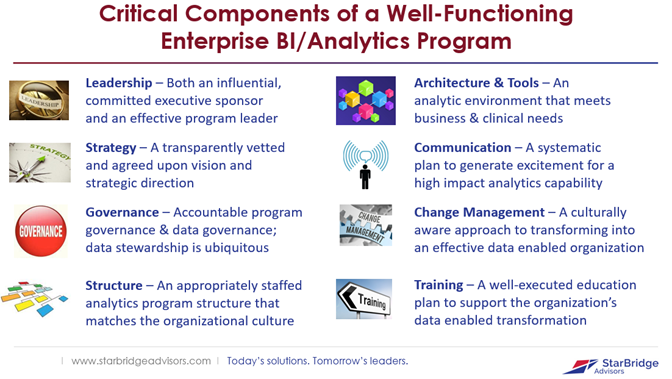 Over 60 years ago information systems were introduced into hospitals and health systems to assist with core financial areas of the business. Soon after, the first electronic medical record systems were installed. With very few exceptions, each and every application had a reporting feature that allowed its users to run various pre-established reports giving them some retrospective financial, operational, and clinical performance reporting. Some even allowed users to create their own personalized reports. Quickly, other departments started acquiring applications to meet their own departmental needs. Often, these also had performance reporting on the data collected by each particular siloed system. When data from different applications needed to be brought together, analysts worked to manually extract it and merge it in various third-party applications such as spreadsheets or databases that they managed separately. As more and more applications were added, it became increasingly difficult and labor intensive to support and rely upon them.
Over 60 years ago information systems were introduced into hospitals and health systems to assist with core financial areas of the business. Soon after, the first electronic medical record systems were installed. With very few exceptions, each and every application had a reporting feature that allowed its users to run various pre-established reports giving them some retrospective financial, operational, and clinical performance reporting. Some even allowed users to create their own personalized reports. Quickly, other departments started acquiring applications to meet their own departmental needs. Often, these also had performance reporting on the data collected by each particular siloed system. When data from different applications needed to be brought together, analysts worked to manually extract it and merge it in various third-party applications such as spreadsheets or databases that they managed separately. As more and more applications were added, it became increasingly difficult and labor intensive to support and rely upon them.
In the current decade, quite a bit of application consolidation has occurred (e.g., most hospitals and health systems have standardized on a single vendor’s EHR) that has alleviated some of the data chaos at least for data that is generated within the suite of modules in the single vendor’s application. However, even with the application consolidation, most hospitals and health systems still have over 70 unique applications on the low end and hundreds at the high end of the spectrum. Despite many vendors claiming to be able to integrate heterogenous data into their core platform, few hospitals and health systems have been able to achieve this to reliably affect their performance reporting needs. Our advisors have assessed the current state of dozens of hospitals and health systems, and despite all of the efforts on application consolidation, when it comes to enterprise analytics (i.e., analyzing data created across the entire spectrum of the health care enterprise in support of strategic and tactical management performance tracking and improvement), the vignette depicted below is a typical example of contemporary analytics at hospitals and health systems.

As arguably one of the most information intensive industries on the planet, how can the above vignette still be a typical example of how hospitals and health systems leverage their enterprise data? The above real vignette amounts to hundreds of hours of manual labor and is prone to human error in the manual manipulation of the data among many different worksheets. From our own experience working with dozens of hospitals and health systems on their enterprise analytics strategic plans, we have found the following:
- The fragmented, departmentally focused management of most analytics at hospitals and health systems makes it very difficult for many organizations to evolve to an enterprise approach.
- Data ownership rights have not been explicitly vetted and agreed upon in many hospitals and health systems.
- Data stewardship within functional business and clinical departments is inconsistent and largely missing as an expected competency within those same functional departments.
- Effective governance of the analytics program overall, as well as data governance is missing at most hospitals and health systems.
- Many hospitals and health systems are missing a C-suite sponsor (not from IT but rather from one of the key business or clinical functions) that strongly “gets” the potential of enterprise analytics and personally champions the accountable evolution of analytics within the organization.
- Many hospitals and health systems have not created a strategic roadmap for developing an effective enterprise analytics capability.
- Few hospitals and health systems perform benefits realization studies to assess the return on investment in their enterprise analytics programs.
- Typically, the analytic technology and tools that have been deployed at many hospitals and health systems is not the key limiting factor, but rather the items listed above play a larger role.
Given these typical findings at many hospitals and health systems, it is not surprising that senior executives are disappointed in the lack of return on investment in their enterprise analytics efforts to date. However, for the most part, they continue to understand that there is unrealized opportunity in the sea of data that is available both within and beyond the proverbial walls of their organizations.
At StarBridge Advisors, we endeavor to help hospitals and health systems launch or re-start their enterprise analytics programs. Our enterprise analytics strategic roadmap engagements seek first to understand the current state of an organization’s reporting, business intelligence and analytics capabilities and with that as a foundation, together with the key data users and stakeholders from the organization work to create a culturally sensitive, executable strategic analytics plan that includes the following components:

With a well-vetted plan founded on these components, organizations are poised to launch/relaunch their enterprise analytics program and accrue benefits from a mastery of data that have formerly been largely unattainable.
